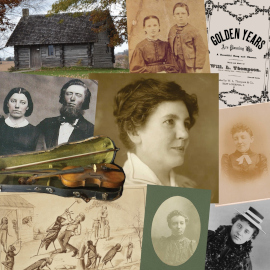Notgrass History’s Laura Ingalls Wilder unit study is an online, multimedia study of the life and times of Laura Ingalls Wilder, author of the Little House on the Prairie books.
Wilder lived from 1867 to 1957, a time full of turbulent changes. The study covers more than the period Wilder wrote about in her books since it begins with Laura’s parents who met and married in Wisconsin. The family moved several times, which expanded Laura’s experiences, many of which we read about in her books. We also track the parents of Almanzo Wilder, who became Laura’s husband.
The study generally follows the timeline of Laura’s life and includes some coverage of the many places she lived. Later in the study, we learn about extended topics, such as music, food, clothing, toys, and games of the era, and what happened to various family members.
Suitable for the entire family, the study is presented on 56 web pages, each with information, photos, videos, maps, and field trip suggestions, plus web links to hands-on activities, recipes, music, and coloring pages. However, every page doesn’t have all of these. For instance, Laura's uncles served in the Union Army during the Civil War, so a page titled “The Civil War in Wisconsin” provides brief information about the Civil War and how volunteers from Wisconsin participated. Following this is a short video, “Wisconsin in the Civil War,” about regiments and volunteers from that state. Next are links to three Wisconsin field trip sites you might visit. Another link to follow for broader coverage of the Civil War takes you to a map of Civil War sites on Homeschool History, Notgrass History’s supplemental resource website. (A subscription is required to use all of the search and filter features of Homeschool History, but the links included in this unit study do not require a subscription.) Following the weblinks is a link to a site with a recipe for making hardtack, the staple food for Civil War soldiers. Lastly, are five coloring pages from Dover’s A Soldier’s Life in the Civil War Coloring Book.
Many pages tie more closely to the Little House books. For example, the page titled “A Long Winter” relates some of the background for Laura’s book titled The Long Winter. The page tells about the winter of 1880-1881, which found the Ingalls family living in De Smet in the Dakota territory. It includes a video about the Garland family and schools in the De Smet area and an image of a train making its way between huge snowbanks. It also has links to songs mentioned in The Long Winter; instructions for making a braided-rug placemat; and recipes for baked beans, cranberry jelly, pumpkin pie, and ginger water.
A few pages have much less content. For example, an overview page about the Little House Books talks about Laura’s authorship of the books, including the significant contributions of her daughter Rose. A link is included to a letter that Laura wrote to children about her books. The article ends with a mention of the Laura Ingalls Wilder Medal, which honors writers and illustrators of children’s books.
Some pages list a particular Little House book that ties specifically to the page’s content. Stopping to read each book at these points would be great, but it certainly extends the study over a much longer time. It’s up to you whether to breeze through the study quickly or take time to explore rabbit trails, read the books, take field trips, or try the recipes.
A few videos were created by Notgrass History particularly for this study, while others are found on the internet. Some videos link tangentially to Laura’s story, such as the one mentioned above, which is included because Laura's family lived in Wisconsin during the Civil War, and one about shipwrecks on Lake Michigan, which is included because her grandfather died in such a shipwreck. Some links are to websites that expand on history and culture in various ways, such as a site with photos and illustrations showing what pioneer weddings were like and a link to a video about the Osage (native American) history and culture.
Six of the pages are dedicated to music and dance, and the study links to many of the songs that Laura mentioned in her books. Maps throughout the study include historical maps as well as modern-day maps to historical sites that you can visit. Some of the historic photos have been turned into online jigsaw puzzles, although you don’t need to solve the puzzles to be able to view the images.
Some elements of this unit study are available free at https://download.notgrass.com/laura-ingalls-wilder, but the entire study is relatively inexpensive for those who love Laura’s books and want to go deeper.








